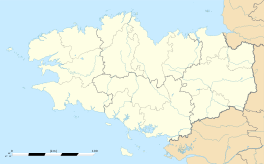Île de Sein
|
Île-de-Sein Enez-Sun |
|
|---|---|

Close-up of the island
|
|
| Coordinates: 48°02′12″N 4°50′58″W / 48.0367°N 4.8494°WCoordinates: 48°02′12″N 4°50′58″W / 48.0367°N 4.8494°W | |
| Country | France |
| Region | Brittany |
| Department | Finistère |
| Arrondissement | Quimper |
| Canton | Pont-Croix |
| Government | |
| • Mayor (2014–2020) | Dominique Salvert |
| Area1 | 0.58 km2 (0.22 sq mi) |
| Population (2008)2 | 214 |
| • Density | 370/km2 (960/sq mi) |
| Time zone | CET (UTC+1) |
| • Summer (DST) | CEST (UTC+2) |
| INSEE/Postal code | 29083 / 29990 |
| Elevation | 0–9 m (0–30 ft) |
|
1 French Land Register data, which excludes lakes, ponds, glaciers > 1 km² (0.386 sq mi or 247 acres) and river estuaries. 2Population without double counting: residents of multiple communes (e.g., students and military personnel) only counted once. |
|
1 French Land Register data, which excludes lakes, ponds, glaciers > 1 km² (0.386 sq mi or 247 acres) and river estuaries.
The Île de Sein is a French island in the Atlantic Ocean, off Finistère, eight kilometres from the Pointe du Raz (raz meaning "water current"), from which it is separated by the Raz de Sein. Its Breton name is Enez Sun. The island, with its neighbouring islets, forms the commune of Île-de-Sein in the Finistère department of Brittany in north-western France.
Lying on the sea routes going south from the English Channel, Sein is well known for the dangers of its waters, the Chaussée de Sein, a vast zone of reefs stretching more than 30 miles from east to west, requiring numerous lighthouses, beacons, and buoys. In the past, it was also known for its wreckers.
There are two megalithic menhirs on the island, which is treeless.
It is mentioned by the Roman geographer Pomponius Mela.
The island women once wore the highest headdresses in Brittany, and had a reputation for enticing sailors onto the rocks by witchcraft. Robert Graves says that the island was once home to a conclave of nine virgin priestesses believed to hold magical powers, who might be approached by those who sailed to consult them.
After hearing General de Gaulle's call to resistance during World War II in his appeal to the French on 18 June 1940, every male inhabitant aged between 14 and 54 (or 60, according to the island's official website) (variously totalled as 114 to 128) set sail in their fishing boats for Britain to join the Free French forces. On 1 January 1946, the commune was for that awarded the high honour of the Order of the Liberation, and its residents exempted from paying income tax; a privilege they enjoy to this day.
...
Wikipedia


